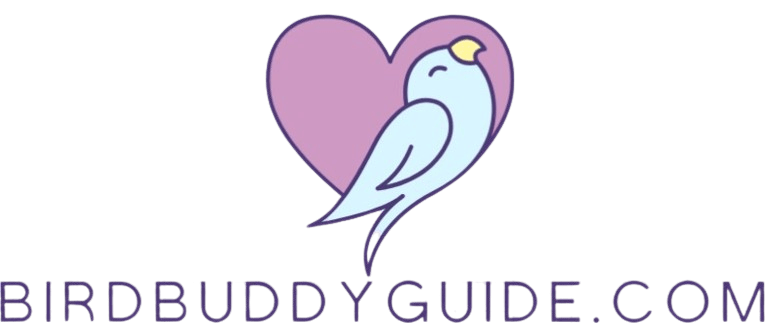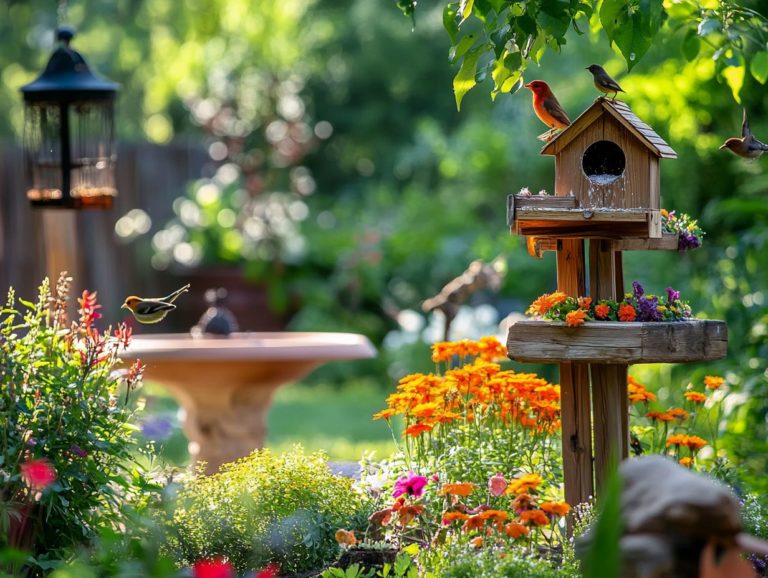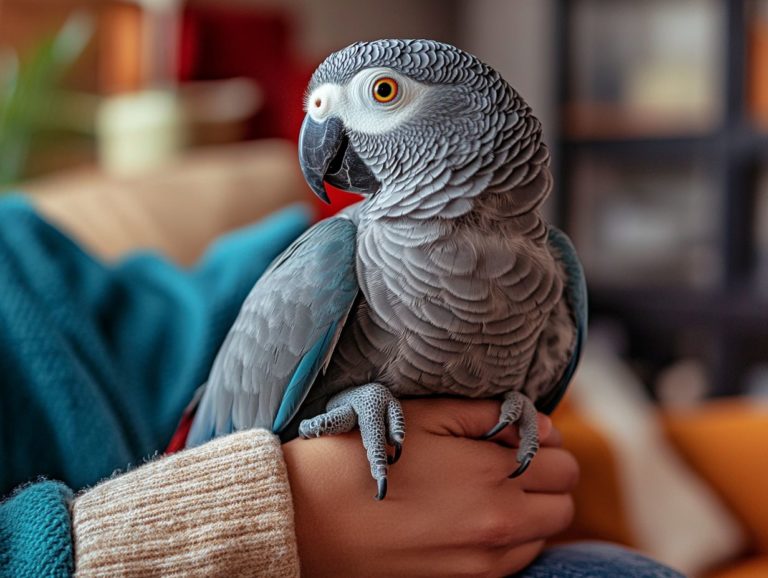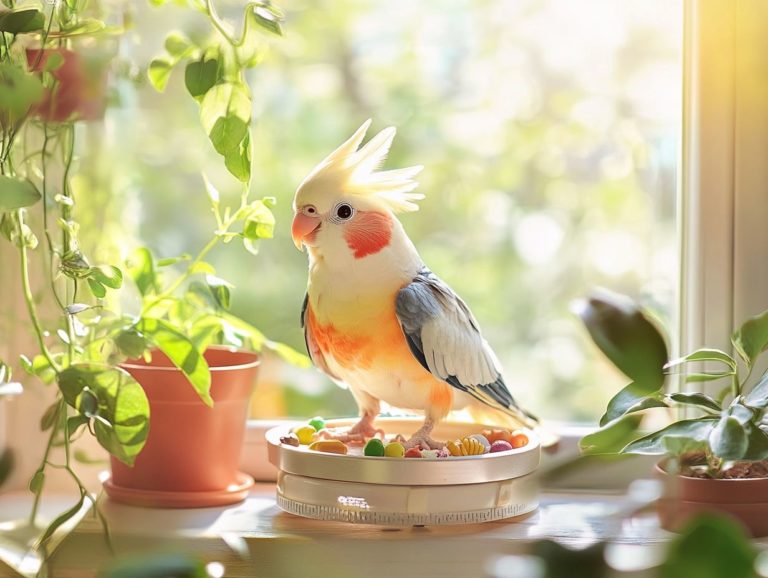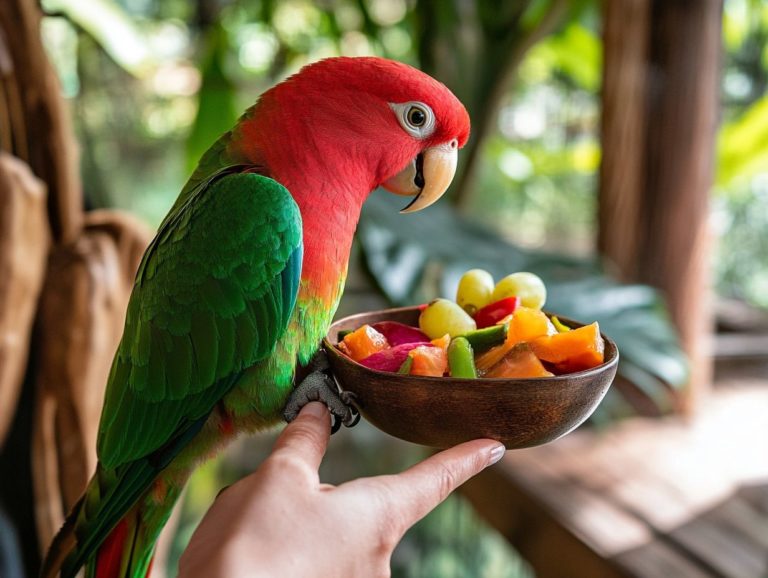Understanding Lovebird Communication
Effective communication is essential in any relationship, especially for lovebirds. These affectionate creatures use a mix of verbal cues, body language, and other signals to express their feelings and strengthen their bonds.
In this exploration, you ll learn about lovebird communication, including their unique sounds and behaviors.
You ll also find practical tips to deepen your connection with your lovebird, ensuring a joyful partnership.
Contents
Key Takeaways:
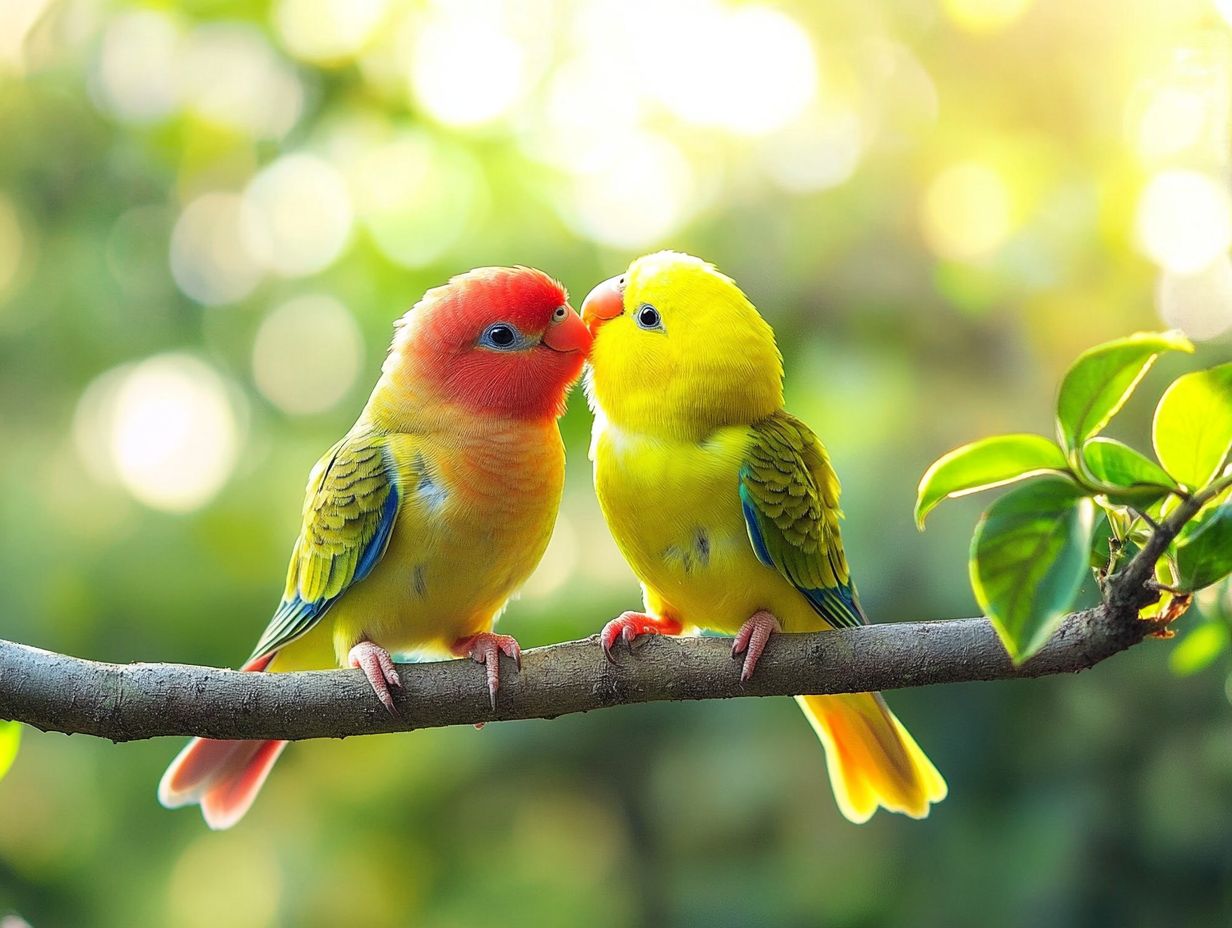
- Lovebirds use vocalizations such as chirping, screaming, crooning, and whistling, along with body language and facial expressions, to communicate.
- Understanding your lovebird’s signals can strengthen your bond and help avoid issues.
- To improve communication, spend quality time with your lovebird, observe their cues, and respond to their needs.
Why is Communication Important for Lovebirds?
Communication is crucial for lovebirds. It helps them express their feelings, whether they re happy or sad.
They make various sounds: soft cooing shows contentment, while sharp squawks may indicate distress. Watch their body language; a puffed-up bird is likely friendly, while one that fluffs and pulls back its head may feel threatened.
By observing these signs, including their chirps and clicks, you can deepen your understanding and strengthen your bond with them.
When lovebirds communicate well, they show peace and security in their environment. This leads to a joyful home life and rewarding interactions with you.
Types of Lovebird Communication
Lovebirds use a variety of sounds and body language to convey their emotions, desires, and needs. This ability helps them connect with their environment and their owners.
Understanding these different forms of communication can help you build a joyful relationship with your lovebirds.
Verbal Communication
Lovebirds use a delightful range of vocalizations, including singing, whistling, chirping, and even mimicking sounds.
These sounds reveal their emotional states. For instance, a high-pitched chirp may mean they are excited, while soft whistles indicate contentment. On the other hand, a loud squawk suggests they feel threatened or lonely.
They often imitate everyday sounds like household noises or other birds showing their natural curiosity. This vibrant communication style deepens the bond between lovebirds and their caretakers.
Body Language
Lovebirds communicate effortlessly through body language, using their posture, feather positions, and movements to give you valuable insights into their moods and intentions. By paying close attention to these signals, you can discern whether your feathered friend is feeling happy, curious, or even a bit distressed.
Watch for a lovebird standing tall this shows confidence and contentment! On the flip side, if they slouch or hunch over, it s a telltale sign that they might be feeling fear or discomfort.
Feather fluffing is another important cue to keep an eye on; it usually signals relaxation or a desire for warmth. However, in certain situations, it can also indicate agitation. Their movement patterns whether they’re enthusiastically hopping around or taking cautious steps offer further clues about their emotional state.
These non-verbal cues not only enhance their vocalizations but also provide a richer context for understanding their needs, helping you connect better with your pet.
Common Lovebird Vocalizations
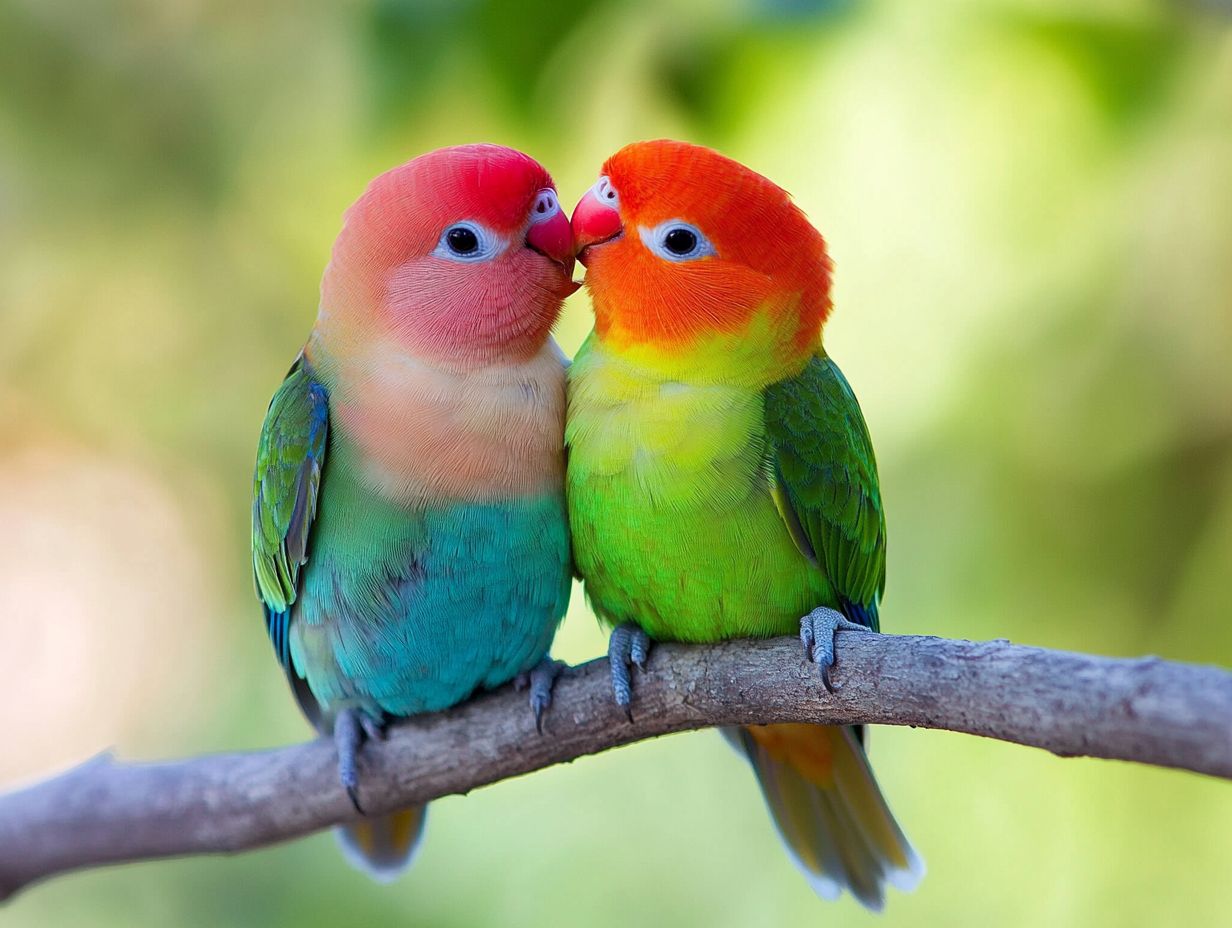
Lovebirds produce a variety of sounds, including chirps, clicks, crooning, and squawking. Each sound serves a unique purpose in their communication. By taking the time to understand these vocalizations, you can respond more effectively to your birds’ emotional states.
Interpreting Different Sounds
Interpreting the various sounds made by lovebirds is crucial for understanding their emotions and needs. Each chirp or whistle has a specific meaning, signaling everything from happiness to discomfort or curiosity.
Pay close attention to the tonal variations and patterns in these vocalizations. For instance, when lovebirds burst into a series of high-pitched whistles, it usually indicates excitement, suggesting they are feeling content and playful.
A raspy or shrill call can signal distress or anxiety, urging you to assess their surroundings for possible stressors. By recognizing these cues, you gain the power to respond appropriately, whether that means offering more social interaction or providing them with some much-needed space.
By responding appropriately, you’ll create a happier and healthier environment for your birds.
Non-verbal Communication in Lovebirds
Non-verbal communication among lovebirds involves an intriguing array of cues, particularly body language and posture. These are essential in conveying their emotions and enhancing social interactions.
These subtle signals often intertwine with their vocalizations, creating a rich understanding of their emotional state.
Posture and Gestures
Posture and gestures are essential elements of lovebird communication. They reveal their emotional states and intentions, whether they re eager for interaction or simply expressing contentment.
Take, for example, a lovebird that fluffs up its feathers and puffs out its chest; this charming display usually signals happiness and excitement, indicating that it feels safe and joyful. Conversely, when a lovebird stands with its feathers tightly pressed against its body, it might be showing fear or stress, suggesting it feels threatened or anxious.
You can also spot curiosity when a lovebird tilts its head to one side. This little gesture indicates interest in its surroundings and a readiness to explore. By honing in on these subtle cues, you can deepen your bond with your feathered companion and respond to its needs more effectively.
Facial Expressions
Facial expressions in lovebirds can reveal much about their emotional states. These subtle gestures reflect their moods and comfort levels during interactions.
These small yet significant gestures are essential for how these charming birds communicate not only with you but also with their fellow feathered friends. For instance, when a lovebird is feeling joyful, its eyes may gleam with brightness, and its demeanor may become animated, often accompanied by playful chirps and a relaxed posture.
On the other hand, a lovebird showing signs of sadness might appear withdrawn, its feathers slightly fluffed as it seeks solitude. You might also notice curious expressions when your lovebird tilts its head or widens its eyes, particularly during new experiences.
By paying close attention to these varied expressions, you can deepen your understanding of your feathered companions and respond appropriately to their emotional needs.
Understanding Lovebird Behavior
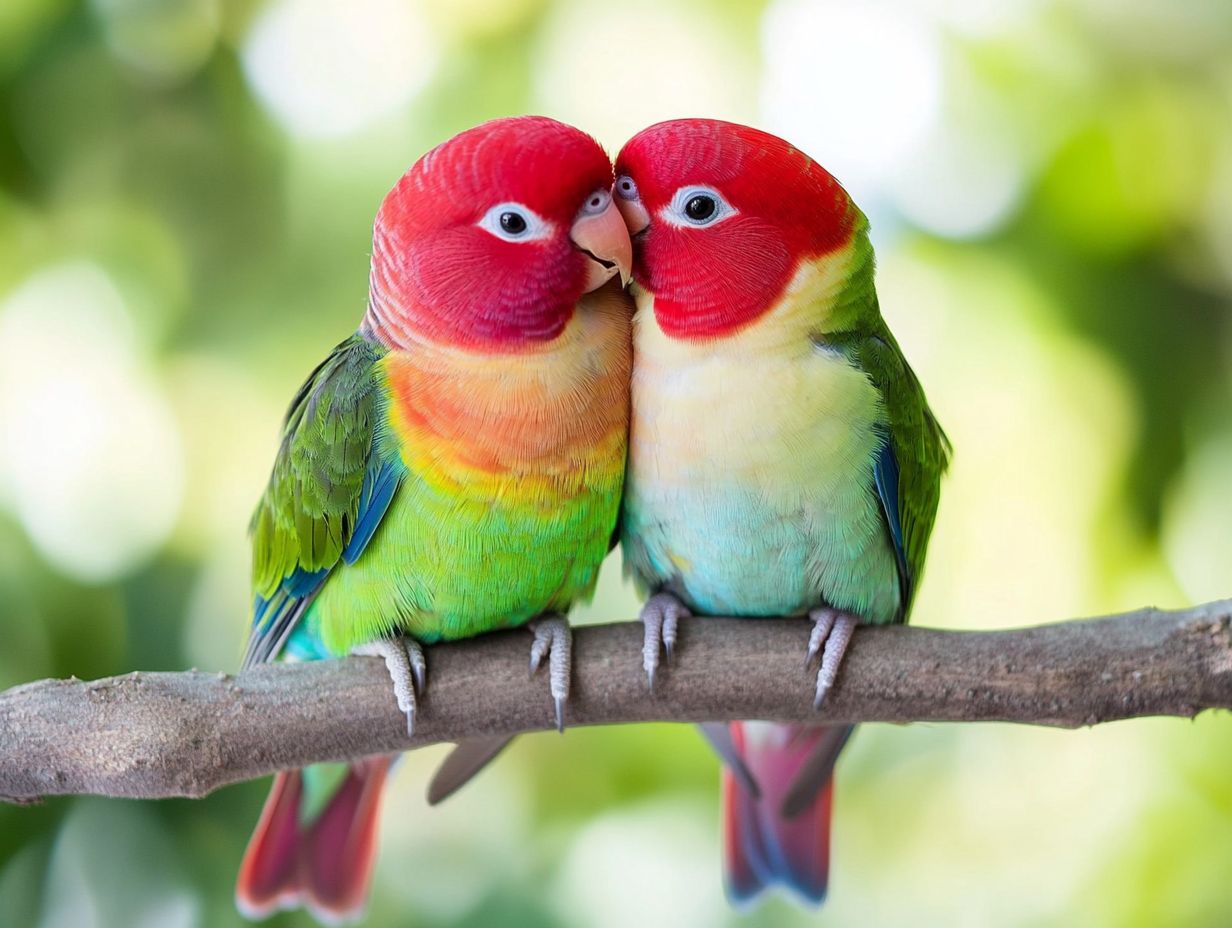
Grasping lovebird behavior is crucial for creating a joyful and thriving environment for these charming creatures. Their actions are closely related to their communication styles and emotional well-being, making it essential for you to recognize and nurture these aspects.
How Communication Affects Behavior
The way lovebirds communicate can significantly influence their behavior. Their vocalizations, or the sounds they make, signal needs, emotions, and social interactions.
By gaining a deeper understanding of this relationship, you can create a more harmonious environment for your feathered companions.
When you pay attention to specific chirps or calls, you may discern shifts in mood or recognize when a bird feels threatened or insecure. For instance, soft coos often convey contentment, while sudden squawks may indicate distress.
Body language is equally important; fluffed feathers or a raised stance can signal a desire for attention or even readiness to bond. By recognizing these subtle cues, you can adjust your interactions accordingly, ensuring that your lovebirds feel secure and understood, ultimately enhancing their overall well-being and happiness.
Tips for Improving Lovebird Communication
Enhancing communication with your lovebirds requires a keen understanding of their needs. This strengthens the bond between you and your feathered companions, leading to a more enriching and interactive relationship.
Pay close attention to their vocalizations and body language; these subtle cues are vital. Create opportunities for social interaction, allowing your lovebirds to flourish in a stimulating environment.
Creating a Bond with Your Lovebird
Creating a strong bond with your lovebird can be a joyful journey! Effective communication is essential for understanding their feelings and building trust.
Engaging in daily interactions whether it’s talking softly, offering gentle strokes, or enjoying playful moments together greatly enhances this connection.
By rewarding good behavior, like giving them treats for desirable actions, you can strengthen their trust and encourage affection.
Observing your lovebird’s cues, such as head bobbing or a relaxed body posture, provides valuable insights into how to respond to their needs appropriately. Establishing a routine filled with patience and joy is vital, allowing your lovebird to thrive in a nurturing environment where they feel secure and cherished.
Frequently Asked Questions
What is lovebird communication?
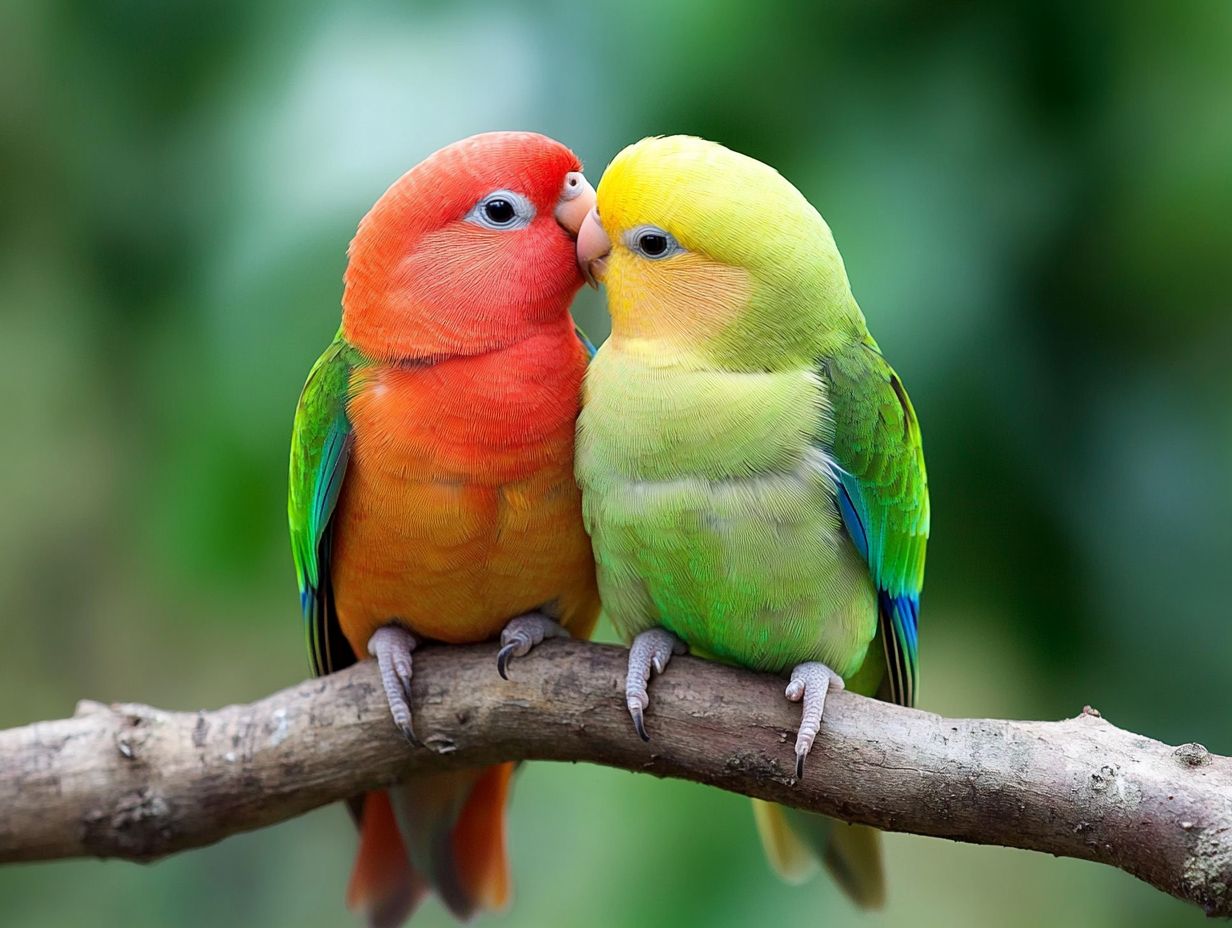
Lovebird communication refers to the various ways in which these small parrots communicate with each other and their owners. This can include vocalizations, body language, and other behaviors.
How do lovebirds communicate with each other?
Lovebirds communicate with each other through a variety of vocalizations, such as chirping, whistling, and squawking. They also use body language, such as fluffing their feathers, to convey messages.
Why is it important to understand lovebird communication?
Understanding lovebird communication helps you bond better with your pet. It allows you to recognize their needs and emotions, preventing misunderstandings.
Can lovebirds communicate with other bird species?
Yes, lovebirds communicate with other bird species using vocalizations and body language. They might struggle with larger parrots that use different communication methods.
How can I improve my understanding of lovebird communication?
Spend time observing your bird’s behavior to grasp their communication. Research common vocalizations and body language cues to interpret their messages better.
Can lovebird communication change over time?
Yes, lovebird communication can evolve as they grow and develop. They might also adjust their communication to suit their environment and interactions.
